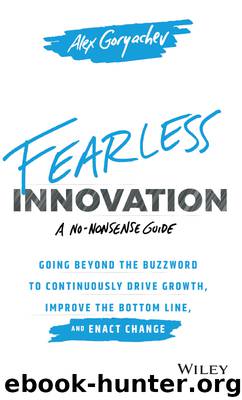Fearless Innovation by Alex Goryachev

Author:Alex Goryachev [Goryachev, Alex]
Language: eng
Format: epub
ISBN: 9781119579588
Publisher: Wiley
Published: 2019-12-16T00:00:00+00:00
Treat Innovation Like a Team Sport
Despite popular belief, invention is not the same as innovation. Just as people confuse disruption with innovation, they get invention, ideation, and innovation all twisted up into one singular concept. They are related, but the distinction is quite simple: invention and ideation are all about coming up with ideas, innovation is about executing on them. To put it in relevant business terms, invention does not require commercial success, but innovation can’t exist without it. Whether innovators develop an idea from scratch or build on successes of the past, they must execute continuously and relentlessly, which is really the only thing that is under their control when it comes to success anyhow. Inventors, on the other hand, can create something, then call it a day.
Consider the number of patents filed every year with the United States Patent and Trademark Office, which receives applications for literally hundreds of thousands of them.9 In 2018, they issued their ten millionth—they’ve been busy since Bell, Morse, Edison, and Ford.10 The year prior, 3.2 million patents were applied for globally.11 Many of those patents will never be acted upon—that’s invention, not innovation. Of course, many inventions are not patented and are kept as trade secrets, like Coca-Cola’s recipe, and some patent activity occurs for other reasons besides commercialization, like image and prestige, not to mention patent trolling. But 97 percent of all US patents never end up making any money, probably because most inventors lack the skills to take their ideas to the market.12 That’s where teams come into play.
Teams are absolutely necessary to figure out whether certain ideas are worth pursuing in the first place, providing insight into their viability (most team members will appreciate their peers’ help with this aspect early on). If they are viable, then working together in teams is the only way to turn these good ideas into reality. Otherwise they’ll never come to fruition. Still, teams will only be successful if they consist of individuals with unique skills, personalities, and backgrounds and who are willing to collaborate, regardless of title or function.
Related to this is the idea that no function or team within an organization should have a monopoly on innovation—not now and not ever. In fact, it’s quite dangerous if only one does. Transformative ideas can occur anywhere, and their scope should not be limited to an employee’s core function or job description. As a leader, it is not your responsibility to “box” your people in, but rather to give them opportunities to explore innovation while helping them to align their efforts with organizational goals. Help them express their ideas and subsequently move beyond ideation and invention. Have them start innovating by connecting them with other employees who are open to the possibilities of innovation and willing to work with cross-functional teams. Effective, cross-functional teams are essential to solving one of the biggest problems hurting even the most successful companies and making it impossible for them to innovate—the dreaded silo mentality.
Download
This site does not store any files on its server. We only index and link to content provided by other sites. Please contact the content providers to delete copyright contents if any and email us, we'll remove relevant links or contents immediately.
Bad Blood by John Carreyrou(6245)
Rich Dad Poor Dad by Robert T. Kiyosaki(6109)
Principles: Life and Work by Ray Dalio(5872)
Playing to Win_ How Strategy Really Works by A.G. Lafley & Roger L. Martin(5311)
Management Strategies for the Cloud Revolution: How Cloud Computing Is Transforming Business and Why You Can't Afford to Be Left Behind by Charles Babcock(4414)
The Confidence Code by Katty Kay(3993)
Thinking in Bets by Annie Duke(3970)
American Kingpin by Nick Bilton(3476)
Delivering Happiness by Tony Hsieh(3255)
Project Animal Farm: An Accidental Journey into the Secret World of Farming and the Truth About Our Food by Sonia Faruqi(2986)
The Power of Habit by Charles Duhigg(2929)
Brotopia by Emily Chang(2870)
Mastering Bitcoin: Programming the Open Blockchain by Andreas M. Antonopoulos(2868)
The Tyranny of Metrics by Jerry Z. Muller(2819)
I Live in the Future & Here's How It Works by Nick Bilton(2817)
The Marketing Plan Handbook: Develop Big-Picture Marketing Plans for Pennies on the Dollar by Robert W. Bly(2762)
The Content Trap by Bharat Anand(2753)
Building a StoryBrand by Donald Miller(2736)
Applied Empathy by Michael Ventura(2723)
